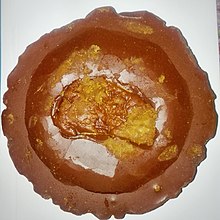Khejurer Gur (Bengali: খেজুরের গুড়, romanized: Khējurēr Guṛ) is a type of jaggery made from date palm sweet sap. The sap is boiled and concentrated to syrup phase by evaporation; gur (jaggery) is prepared by cooling the concentrated syrup. Khejurer Gur is available in two forms — patali (solid) and nolen or jhola (liquid).[1][2] The word Khejur generally refers to the Date palm while the word Gur refers to jaggery.
 | |||||||
| Place of origin | Indian subcontinent | ||||||
|---|---|---|---|---|---|---|---|
| Region or state | Bengal and Orissa | ||||||
| Variations | patali and nolen | ||||||
| 355 kcal (1486 kJ) | |||||||
| |||||||
The history of Khejurer Gur production in the Indian subcontinent is very old. Nolen Gur, a type of Khejurer Gur (or molasses), is mentioned in the Sanskrit Kāvya Sadukti-Karnamrta by Sridhardas.[3] In 1837, the first Khejurer Gur factory was established at Dhoba near Bardwan in West Bengal. West Bengal and Orissa in India and Jessore and Faridpur districts in Bangladesh are famous for producing Khejurer Gur.
Khejurer Gur plays an important role in culinary styles, especially Bengali cuisine. This jaggery is a very important ingredient for pitha preparation, which adds flavor and aroma to pitha. The Kolkata is famous for its use of Nolen gur in Sandesh and sweets.
History
editThe palm jaggery and palm products industry in India dates back to about 4000 years old, and is an essential traditional village industry.[4] Sridhardas, son of Sri Bhatudas, the most powerful of Lakshmana Sen's feudal lords (Mahasamantachuramani), is the author of the Sanskrit Kāvya Sadukti-Karnamrta. Historian Niharranjan Roy, in his book History of Bengali Adiparva, mentions that Nolen Gur is described in this Sanskrit poetic text. Besides, he also mentioned that he found mention of dates in Dharmapala's Khalimpur inscription. Preparation of Khejurer Gur by the Sora people of Odisha has a history.
The southern districts of West Bengal and the southwestern districts of Bangladesh are more famous for Khejurer Gur. Jessore, Faridpur, Undivided Twenty-four Parganas and Nadia district have been famous for gur (jaggery) production for centuries. According to the book History of Jessohar Khulna written by historian Satish Chandra Mitra, 21 lakh 80 thousand 550 maunds of Khejurer Gur were produced in East Bengal in 1900-1901, of which 17 lakh 9 thousand 960 maunds of gur were produced in Jessore alone. The first date palm jaggery and sugar factory was established in 1837 at Dhoba near Burdwan in West Bengal, which was the first industrialization of palm sugar production in India. In 1861, Mr. Newhouse built a factory for the production of date palm jaggery and sugar at Taherpur on the banks of the Kapotaksha River in Chougacha. Later, 117 factories were established in different villages of Jessore.[3]
References
edit- ^ Chakraborty, Barnini Maitra (12 January 2024). "Palm to plate: How to get nolen gur from across West Bengal delivered to your doorstep this winter". The Telegraph. Retrieved 19 November 2024.
Be it the cubes of patali or the liquid jhola, the gooey, sticky date-palm jaggery has to feature in mealtimes and people wait for the fresh batches of gur every season.
- ^ Banka, Neha (19 March 2023). "Nolen gur, West Bengal's beloved seasonal food stares at a bitter future". The Indian Express. Nadia. Retrieved 19 November 2024.
In his shop outside Majdiha's railway station, Jhantu Das has been selling blocks of jaggery and jars full of liquid nolen gur, also called jhola gur, for over a decade...."Farmers say that because the roots of the date palm tree don't go very deep into the soil, they aren't getting enough water, resulting in low yields of sap. It is likely one reason behind the low production of jaggery," he says.
- ^ a b Rahman, Sheikh Saifur (30 January 2020). "গুড়কীর্তন". Prothom Alo (in Bengali). Retrieved 19 November 2024.
সদুক্তিকর্ণামৃত নামের সংস্কৃত কাব্যগ্রন্থের রচয়িতা শ্রীধরদাস।...নলেন গুড়ের বন্দনা আছে বলে উল্লেখ করেছেন ঐতিহাসিক নিহাররঞ্জন রায়, তাঁর গ্রন্থ বাঙ্গালীর ইতিহাস আদিপর্ব-এ।...এ ছাড়া খেজুরের উল্লেখ ধর্মপালের খালিমপুর-লিপিতে পেয়েছেন বলেও উল্লেখ করেছেন তিনি।
- ^ Registrar 2023, p. 11.
Bibliography
edit- Registrar (31 August 2023). "Geographical Indications Journal No 178". Geographical Indications Journal. Intellectual Property India.